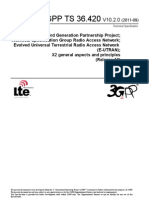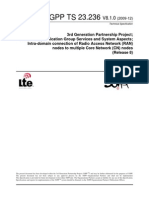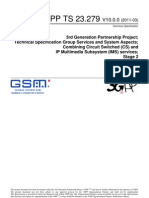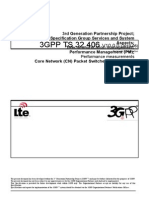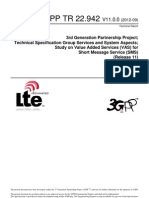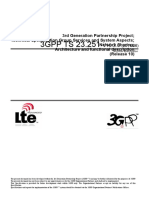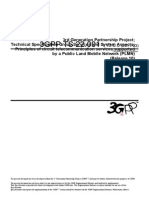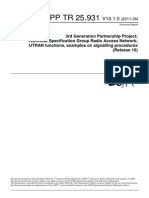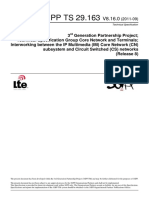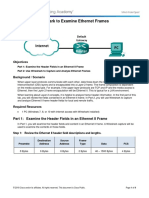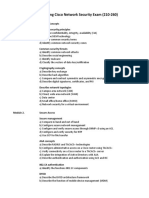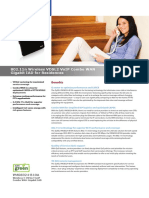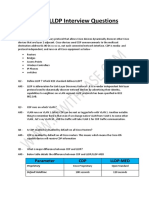3GPP TS 32.401
3GPP TS 32.401
Uploaded by
Blue Blooded BedouinCopyright:
Available Formats
3GPP TS 32.401
3GPP TS 32.401
Uploaded by
Blue Blooded BedouinOriginal Title
Copyright
Available Formats
Share this document
Did you find this document useful?
Is this content inappropriate?
Copyright:
Available Formats
3GPP TS 32.401
3GPP TS 32.401
Uploaded by
Blue Blooded BedouinCopyright:
Available Formats
3GPP TS 32.401 V10.1.
0 (2011-06)
Technical Specification
3rd Generation Partnership Project; Technical Specification Group Services and System Aspects; Telecommunication management; Performance Management (PM); Concept and requirements (Release 10)
The present document has been developed within the 3rd Generation Partnership Project (3GPP TM) and may be further elaborated for the purposes of 3GPP. The present document has not been subject to any approval process by the 3GPP Organisational Partners and shall not be implemented. This Specification is provided for future development work within 3GPP only. The Organisational Partners accept no liability for any use of this Specification. Specifications and reports for implementation of the 3GPP TM system should be obtained via the 3GPP Organisational Partners' Publications Offices.
Release 10
3GPP TS 32.401 V10.1.0 (2011-06)
UMTS, management, performance
Keywords
3GPP Postal address 3GPP support office address
650 Route des Lucioles - Sophia Antipolis Valbonne - FRANCE Tel.: +33 4 92 94 42 00 Fax: +33 4 93 65 47 16
Internet
http://www.3gpp.org
Copyright Notification No part may be reproduced except as authorized by written permission. The copyright and the foregoing restriction extend to reproduction in all media.
2011, 3GPP Organizational Partners (ARIB, ATIS, CCSA, ETSI, TTA, TTC). All rights reserved. UMTS is a Trade Mark of ETSI registered for the benefit of its members 3GPP is a Trade Mark of ETSI registered for the benefit of its Members and of the 3GPP Organizational Partners LTE is a Trade Mark of ETSI currently being registered for the benefit of its Members and of the 3GPP Organizational Partners GSM and the GSM logo are registered and owned by the GSM Association
3GPP
Release 10
3GPP TS 32.401 V10.1.0 (2011-06)
Contents
Foreword..................................................................................................................................................4 Introduction..............................................................................................................................................4 1 Scope....................................................................................................................................................6 2 References.............................................................................................................................................7 3 Definitions and abbreviations...............................................................................................................8
3.1 Definitions.............................................................................................................................................................8 3.2 Abbreviations.........................................................................................................................................................9
4 Concept...............................................................................................................................................10
4.1 Measurement result data requirements...............................................................................................................11 4.1.1 Traffic measurements.......................................................................................................................................11 4.1.2 Network configuration evaluation...................................................................................................................11 4.1.3 Resource access................................................................................................................................................11 4.1.4 Quality of Service (QoS)..................................................................................................................................12 4.1.5 Resource availability........................................................................................................................................12 4.2 Measurement administration...............................................................................................................................12 4.2.1 Measurement job administration......................................................................................................................12 4.2.2 Measurement result generation........................................................................................................................13 4.2.3 Local storage of results at the NE/EM.............................................................................................................14 4.2.4 Measurement result transfer.............................................................................................................................14 4.2.5 Performance data presentation.........................................................................................................................14 4.3 Measurement type definitions.............................................................................................................................14 4.3.1 Nature of the result...........................................................................................................................................14 4.3.2 Perceived accuracy...........................................................................................................................................15 4.3.3 Comparability of measurement result data......................................................................................................15 4.3.4 Measurement identification..............................................................................................................................16 4.3.5 (n-1) out of n approach.....................................................................................................................................16 4.4 Performance alarms.............................................................................................................................................16
5 Functional requirements......................................................................................................................17
5.1 Introduction..........................................................................................................................................................17 5.2 Basic functions....................................................................................................................................................17 5.3 Plug & Measure...................................................................................................................................................20 5.4 Measurement jobs................................................................................................................................................20 5.4.1 Measurement job characteristics......................................................................................................................20 5.4.1.1 Measurement types........................................................................................................................................20 5.4.1.2 Measurement sub-types.................................................................................................................................20 5.4.1.3 Measurement schedule..................................................................................................................................21 5.4.1.4 Granularity period.........................................................................................................................................21 5.4.1.5 Measurement reporting.................................................................................................................................21 5.4.1.6 Illustration of the measurement scheduling principles.................................................................................21 5.4.2 Measurement job state and status attributes....................................................................................................22 5.4.3 Measurement job administration......................................................................................................................22 5.5 Measurement results............................................................................................................................................23 5.5.1 Measurement result characteristics..................................................................................................................23 5.5.2 Transfer of measurement results......................................................................................................................23 5.6 Usage of Alarm IRP for performance alarms.....................................................................................................24 5.7 Threshold Management.......................................................................................................................................25
Annex A (informative): Change history......................................................................................29
3GPP
Release 10
3GPP TS 32.401 V10.1.0 (2011-06)
Foreword
This Technical Specification (TS) has been produced by the 3rd Generation Partnership Project (3GPP). The contents of the present document are subject to continuing work within the TSG and may change following formal TSG approval. Should the TSG modify the contents of the present document, it will be re-released by the TSG with an identifying change of release date and an increase in version number as follows: Version x.y.z where: x the first digit: 1 presented to TSG for information; 2 presented to TSG for approval; 3 or greater indicates TSG approved document under change control. y the second digit is incremented for all changes of substance, i.e. technical enhancements, corrections, updates, etc. z the third digit is incremented when editorial only changes have been incorporated in the document.
Introduction
The present document is part of a TS-family covering the 3rd Generation Partnership Project; Technical Specification Group Services and System Aspects; Telecommunication Management; Performance Management (PM), as identified below: TS 32.401: TS 52.402: TS 32.404: TS 32.405: TS 32.406: "Concept and requirements"; "Performance measurements - GSM"; "Performance measurements - Definitions and template"; "Performance measurements Universal Terrestrial Radio Access Network (UTRAN)"; "Performance measurements Core Network (CN) Packet Switched (PS) domain";
TS 32.407: "Performance measurements Core Network (CN) Circuit Switched (CS) domain; UMTS and combined UMTS/GSM"; TS 32.408: TS 32.409: TS 32.425: TS 32.426: TS 32.452: TS 32.453: "Performance measurements Teleservice"; "Performance measurements IP Multimedia Subsystem (IMS)"; "Performance measurements Evolved Universal Terrestrial Radio Access Network (E-UTRAN)"; "Performance measurements Evolved Packet Core (EPC) network"; "Performance measurements Home Node B (HNB) Subsystem HNS"; "Performance measurements Home enhanced Node B (HeNB) Subsystem (HeNS)".
The present document is part of a set of specifications, which describe the requirements and information model necessary for the standardised Operation, Administration and Maintenance (OA&M) of a multi-vendor GSM, UMTS or LTE PLMN. During the lifetime of a PLMN, its logical and physical configuration will undergo changes of varying degrees and frequencies in order to optimise the utilisation of the network resources. These changes will be executed through network configuration management activities and/or network engineering, see 3GPP TS 32.600 [3].
3GPP
Release 10
3GPP TS 32.401 V10.1.0 (2011-06)
Many of the activities involved in the daily operation and future network planning of a PLMN network require data on which to base decisions. This data refers to the load carried by the network and the grade of service offered. In order to produce this data performance measurements are executed in the NEs, which comprise the network. The data can then be transferred to an external system, e.g. an Operations System (OS) in TMN terminology, for further evaluation. The purpose of the present document and its companion parts 2 and 3 is to describe the mechanisms involved in the collection of the data and the definition of the data itself.
3GPP
Release 10
3GPP TS 32.401 V10.1.0 (2011-06)
1 Scope
The present document describes the requirements for the management of performance measurements and the collection of performance measurement result data across GSM, UMTS and LTE networks. It defines the administration of measurement schedules by the Network Element Manager (EM), the generation of measurement results in the Network Elements (NEs) and the transfer of these results to one or more Operations Systems, i.e. EM(s) and/or Network Manager(s) (NM(s)). The basic Performance Management concept that the present document is built upon is described in clause 4. The requirements of how an EM administers the performance measurements and how the results can be collected are defined in detail in clause 5. Measurements available for collection by NEs are described in the following specifications: TS 52.402 for GSM systems; TS 32.405, TS 32.406, TS 32.407 and TS 32.408 for UMTS and combined UMTS/GSM systems; TS 32.409 for IMS networks; TS 32.425 for E-UTRAN. TS 32.426 for EPC. TS 32.452 for Home Node B (HNB) Subsystem (HNS). TS 32.453 for Home enhanced Node B (HeNB) Subsystem (HeNS).
Effort has been made to ensure consistency in the definition of measurements between different NEs and generations. The performance measurement result is described in Performance Measurement File Format Definition (3GPP TS 32.432 [29]). The following is beyond the scope of the present document, and therefore the present document does not describe: the formal definition of the interface that the EM uses to administer performance measurements in the NEs; the formal definition of the interface that the EM uses to collect measurement results from the NEs; how the data, once accumulated and collected, could or should be processed, stored, or presented to an end user; the information which may be obtained through the collection and processing of call or event related records which have been produced by the NEs primarily for the purpose of raising bills and other charges.
The management requirements have been derived from existing telecommunications operations experience. The management definitions were then derived from other standardisation work so as to minimise the re-invention factor. References are given as appropriate. The objectives of this standardisation are: to provide the descriptions for a standard set of measurements; to produce a common description of the management technique for measurement administration and result accumulation; and to define a method for the bulk transmission of measurement results across a management interface.
The definition of the standard measurements is intended to result in comparability of measurement result data produced in a multi-vendor wireless network, for those measurement types that can be standardised across all vendors' implementations. As far as possible, existing standardisation in the area of Performance Management has been re-used and enhanced where particular requirements, peculiar to the mobile telephony environment, have been recognised.
3GPP
Release 10
3GPP TS 32.401 V10.1.0 (2011-06)
The present document considers all the above aspects of Performance Management for a GSM, UMTS or LTE network and its NEs defined in the core Technical Specifications. However, only those aspects which are specific to a GSM/UMTS/LTE system and particular to wireless network operation are included in the present document.
2 References
The following documents contain provisions which, through reference in this text, constitute provisions of the present document. References are either specific (identified by date of publication, edition number, version number, etc.) or non-specific. For a specific reference, subsequent revisions do not apply. For a non-specific reference, the latest version applies. In the case of a reference to a 3GPP document (including a GSM document), a non-specific reference implicitly refers to the latest version of that document in the same Release as the present document. [1] [2] [3] [4] [5] [6] [7] [8] [9] [10] [11] [12] [13] - [19] [20] [21] [22] [23] [24] [25] 3GPP TS 32.101: "Telecommunication management; Principles and high level requirements". 3GPP TS 32.102: "Telecommunication management; Architecture". 3GPP TS 32.600: "Telecommunication management; Configuration Management (CM); Concept and high-level requirements". 3GPP TS 25.442: "UTRAN Implementation Specific O&M Transport". ITU-T Recommendation E.880: "Field data collection and evaluation on the performance of equipment, networks and services". ITU-T Recommendation X.731: "Information technology - Open Systems Interconnection Systems Management: State management function". ISO 8571: "Information processing systems - Open Systems Interconnection - File Transfer, Access and Management". Void. 3GPP TS 32.300: "Telecommunication management; Configuration Management (CM); Name convention for Managed Objects". 3GPP TS 32.302: "Telecommunication management; Configuration Management (CM); Notification Integration Reference Point (IRP): Information Service". 3GPP TS 32.111-1: "Telecommunication management; Fault Management; Part 1: 3G fault management requirements". Void. 3GPP TR 32.800: "Telecommunication management; Management level procedures and interaction with UTRAN". 3GPP TS 32.111-2: "Telecommunication management; Fault Management; Part 2: Alarm Integration Reference Point (IRP): Information Service (IS)". 3GPP TS 52.402: "Telecommunication management; Performance Management (PM); Performance measurements - GSM". Void. 3GPP TS 32.622: "Telecommunication management; Configuration Management (CM); Generic network resources Integration Reference Point (IRP): Network Resource Model (NRM)". W3C REC-xml-20001006: "Extensible Markup Language (XML) 1.0 (Second Edition)".
3GPP
Release 10
3GPP TS 32.401 V10.1.0 (2011-06)
[26] [27] [28] [29] [30] [31] [32] [33] [34] [35] [36] [37] [38] [39] [40]
W3C REC-xmlschema-0-20010502: "XML Schema Part 0: Primer". W3C REC-xmlschema-1-20010502: "XML Schema Part 1: Structures". W3C REC-xmlschema-2-20010502: "XML Schema Part 2: Datatypes". 3GPP TS 32.432: "Telecommunication management; Performance Measurement File Format Definition". 3GPP TS 32.342: "Telecommunication management; File Transfer (FT) Integration Reference Point (IRP): Information Service (IS)". 3GPP TS 32.404: "Telecommunication management; Performance Management (PM); Performance measurements - Definitions and template". 3GPP TS 32.405: "Telecommunication management; Performance Management (PM); Performance measurements - Universal Terrestrial Radio Access Network (UTRAN)". 3GPP TS 32.406: "Telecommunication management; Performance Management (PM); Performance measurements - Core Network (CN) Packet Switched (PS) domain". 3GPP TS 32.407: "Telecommunication management; Performance Management (PM); Performance measurements - Core Network (CN) Circuit Switched (CS) domain". 3GPP TS 32.408: "Telecommunication management; Performance Management (PM); Performance measurements - Teleservice". 3GPP TS 32.409: "Telecommunication management; Performance Management (PM); Performance measurements - IP Multimedia Subsystem (IMS)". 3GPP TS 32.425: "Telecommunication management; Performance Management (PM); Performance measurements Evolved Universal Terrestrial Radio Access Network (E-UTRAN). 3GPP TS 32.426: "Telecommunication management; Performance Management (PM); Performance measurements Evolved Packet Core (EPC) network. 3GPP TS 32.452: "Telecommunication management; Performance Management (PM); Performance measurements Home Node B (HNB) Subsystem (HNS). 3GPP TS 32.453: "Telecommunication management; Performance Management (PM); Performance measurements Home enhanced Node B (HeNB) Subsystem (HeNS).
3 Definitions and abbreviations
3.1 Definitions
For the purposes of the present document, the following terms and definitions apply: network Element Manager (EM): provides a package of end-user functions for management of a set of closely related types of Network Elements. These functions can be divided into two main categories: Element Management Functions for management of Network Elements on an individual basis. These are basically the same functions as supported by the corresponding local terminals. Sub-Network Management Functions that are related to a network model for a set of Network Elements constituting a clearly defined sub-network, which may include relations between the Network Elements. This model enables additional functions on the sub-network level (typically in the areas of network topology presentation, alarm correlation, service impact analysis and circuit provisioning).
Network Manager (NM): provides a package of end-user functions with the responsibility for the management of a network, mainly as supported by the EM(s) but it may also involve direct access to the Network Elements. All communication with the network is based on open and well-standardised interfaces supporting management of multivendor and multi-technology Network Elements.
3GPP
Release 10
3GPP TS 32.401 V10.1.0 (2011-06)
Operations System (OS): generic management system, independent of its location level within the management hierarchy.
3.2
Abbreviations
3rd Generation Access Grant Channel Access Point Name Abstract Syntax Notation 1 Authentication Centre Basic Encoding Rules Base Station Controller Base Station System BSS Application Part Base Transceiver Station Cell Broadcast Channel Common Control Channel Dedicated Control Channel Data Communication Network Discrete Event Registration Equipment Identity Register (Network) Element Manager Evolved Packet Core Evolved Universal Terrestrial Radio Access Network Fast Associated Control Channel File Transfer Access and Management File Transfer Protocol Gateway GPRS Service Node Gateway Mobile Services Switching Centre General Packet Radio Service Global System for Mobile communications GPRS Service Node Home Location Register Handover Home PLMN International Mobile Equipment Identity International Mobile Subscriber Identity Integrated Service Digital Network International Standards Organisation Interface Logical Link Control Location Register Long Term Evolution Mobile Station Mobile Services Switching Centre Mobile Subscriber Roaming Number Message Transfer Part Network Element Network Manager Network Sub System (including EIR, HLR, SMS-IWMSC, MSC and VLR) Operation, Administration and Maintenance Off-Air Call Set Up Operations System (EM, NM) Open Systems Interconnection Packet Common Control Channel Packet Paging Channel Paging Channel Public Land Mobile Network Performance Management Packet Traffic Channel
For the purposes of the present document, the following abbreviations apply: 3G AGCH APN ASN.1 AuC BER BSC BSS BSSAP BTS CBCH CCCH DCCH DCN DER EIR EM EPC E-UTRAN FACCH FTAM FTP GGSN GMSC GPRS GSM GSN HLR HO HPLMN IMEI IMSI ISDN ISO Itf LLC LR LTE MS MSC MSRN MTP NE NM NSS OA&M OACSU OS OSI PCCCH PCCH PCH PLMN PM PTCH
3GPP
Release 10
10
3GPP TS 32.401 V10.1.0 (2011-06)
PVLR QoS RACH Rec. RF RNC RR RXLEV RXQUAL SACCH SCCP SDCCH SGSN SMS-IWMSC SNDCP SS TCAP TCH TFTP TMN TMSI UE UMTS UTRAN VLR
Previous VLR Quality of Service Random Access Channel Recommendation Radio Frequency Radio Network Controller Radio Resource Reception Level Reception Quality Slow Associated Control Channel (ITU-T) Signalling Connection Control Part Stand alone Dedicated Control Channel Serving GPRS Service Node Short Message Service Inter Working MSC Sub Network Dependency Control Protocol Supplementary Service (ITU-T) Transaction Capabilities Application Part Traffic Channel Trivial FTP Telecommunications Management Network Temporary Mobile Subscriber Identity User Equipment Universal Mobile Telecommunications System Universal Terrestrial Radio Access Network Visitors Location Register
4 Concept
Any evaluation of PLMN-system behaviour will require performance data collected and recorded by its NEs according to a schedule established by the EM. This aspect of the management environment is termed Performance Management. The purpose of any Performance Management activity is to collect data, which can be used to verify the physical and logical configuration of the network and to locate potential problems as early as possible. The type of data to be collected is defined by the equivalent measurements (refer to TS 52.402 [22] and TS32.404 [31]). The present document concentrates on the requirements of GSM, UMTS and LTE telecom management to produce this data. Any management actions performed at the OSs subsequently to analyse the performance data are not considered in the present document. Data is required to be produced by the NEs to support the following areas of performance evaluation: traffic levels within the network, including the level of both the user traffic and the signalling traffic (clause 4.1.1); verification of the network configuration (clause 4.1.2); resource access measurements (clause 4.1.3); Quality of Service (e.g. delays during call set-up, packet throughput, etc) (clause 4.1.4); and resource availability (e.g. the recording of begin and end times of service unavailability) (clause 4.1.5).
The production of the measurement result data by the NEs also needs to be administered by the EM. Several phases of administration of performance measurements can be distinguished: the management of the performance measurement collection process (clause 4.2.1); the generation of performance measurement results (clause 4.2.2); the local storage of measurement results in the NE (clause 4.2.3); the transfer of measurement results from the NE to an OS (EM and/or NM) (clause 4.2.4); and the storage, preparation and presentation of results to the operating personnel (clause 4.2.5).
3GPP
Release 10
11
3GPP TS 32.401 V10.1.0 (2011-06)
In respect to the evaluation of the results produced by the measurements the following has to be considered: to understand the nature of the results received from the network (clause 4.3.1); to assure the reliability and accuracy of the measurement results (clause 4.3.2); to ensure comparable measurement results for the same measurements being performed in equipment from different vendors (clause 4.3.3); the ability to identify the results in the management systems: with respect to the measurement jobs by the EM, and with respect to the measurement types and measured resources by the NM (clause 4.3.4); and to take into account that, in a set of n correlated measurements, any (n-1) out of the defined n measurements may be provided by the network (clause 4.3.5).
Performance measurements may also be used to supervise operator defined threshold values and generate alarms upon exceeding the thresholds (clause 4.4). The following clauses provide further background on the performance measurement concept that is applicable to GSM, UMTS and LTE networks. Although any implementation of GSM, UMTS and LTE network elements shall adopt the concept described below, not all of the text - due to its conceptual nature - is usable to actually determine compliance of the equipment. In these cases, more strictly specified requirements, against which conformance shall be proven, are found in clause 5 of the present document.
4.1
Measurement result data requirements
This clause describes the typical requirements for performance data to be produced by the NEs, which comprise a GSM, UMTS or LTE network. It is important to note that an actual measurement value collected from the network may be used to satisfy requirements in more than one category of measurement described below.
4.1.1
Traffic measurements
Traffic measurements provide the data from which, among other uses, the planning and operation of the network can be carried out. The types of traffic evaluations for which PLMN specific measurements may be used include: traffic load on the radio or core network interfaces (signalling and user traffic); usage of resources within the network nodes; user activation and use of supplementary services, etc.
Examples of measured values may include: pages per location area per hour; busy hour call attempts per BSC, RNC, MSC; handovers per BSC/RNC per hour, etc.
4.1.2
Network configuration evaluation
Once a network plan, or changes to a network plan, have been implemented it is important to be able to evaluate the effectiveness of the plan or planned changes. Typically, the measurements required to support this activity indicate the traffic levels with particular relevance to the way the traffic uses the network.
4.1.3
Resource access
For accurate evaluation of resource access, each measurement result would need to be produced for regular time intervals across the network, or for a comparable part of the network.
3GPP
Release 10
12
3GPP TS 32.401 V10.1.0 (2011-06)
4.1.4
Quality of Service (QoS)
The user of a PLMN views the provided service from outside the network. That perception can be described in observed QoS terms. QoS can indicate the network performance expected to be experienced by the user. For further detail see ITU-T Recommendation E.880 [5]. The QoS parameters applied by the network to specific user services may also be relevant to determine the charges levied towards the user for the provision of those services.
4.1.5
Resource availability
The availability performance is dependent on the defined objectives, i.e. the availability performance activities carried out during the different phases of the life cycle of the system, and on the physical and administrative conditions. For further detail see ITU-T Recommendation E.880 [5].
4.2
Measurement administration
The range of measurements which will be available from the NEs are expected to cover all of the requirements described in clause 4.1. However, not all of these measurements will be required all of the time, from every occurrence, of every relevant NE. Therefore, it is necessary to administer the measurements so as to determine which measurement types, on which measured resources, at which times, are to be executed. With a highly distributed network like a GSM, UMTS or LTE mobile telecommunication system it is also necessary to gather the measurement result data so as to perform consistent analysis of the results and to evaluate the interactions between the NEs. This clause describes the requirements for the various areas of administration of measurements.
4.2.1
Measurement job administration
Measurement jobs, i.e. the processes which are executed in the NEs in order to accumulate measurement result data and assemble it for collection and/or inspection, will need to be scheduled by the EM for the period or periods for which gathering of data shall be performed. The administration of measurement jobs by the EM comprises the following actions: 1) Create/delete a measurement job. This action implies the instantiation respectively deletion of a measurement collection process within the network. 2) Modifying a measurement job, i.e. changing the parameters (specifically the schedule) of a measurement job that has been previously created. 3) Definition of measurement job scheduling. This action defines the period or periods during which the measurement job is configured to collect performance data. 4) Specification of the measurement types to be contained in the job, e.g. "number of GPRS attach attempts". In GSM, the measurement jobs are administered by individual measurement types, which are specified in TS 52.402 [22]. In UMTS and LTE, the measurement jobs may be administered per individual measurement type or per measurement family, which comprises a collection of related measurement types. The measurement types and families for UMTS and combined GSM/UMTS networks are specified in TS 32.405 [32], TS 32.406 [33], TS 32.407 [34], TS 32.408 [35] and specified in TS 32.409 [36] for IMS. Measurement types and families for E-UTRAN are specified in TS 32.425 [37] and for EPC in TS 32.426 [38]. Measurement types and families for Home Node B (HNB) Subsystem (HNS) are defined in TS 32.452 [39] and for Home enhanced Node B (HeNB) Subsystem (HeNS) in TS.32.453 [40]. 5) Identification of the measured resources, i.e. the NEs (e.g. MSC, NodeB) or NE components (e.g. trunkgroups, radio channels, transceivers) to which the measurement types or measurement families, specified in the measurement job, pertain. 6) Suspend/resume a measurement job. The "suspend" action inhibits the collection of measurement result data by a measurement job, regardless of its schedule, without deleting it. The "resume" action will re-enable measurement result data collection according to the measurement job schedule. It may also be possible for the system to suspend a measurement job without any operators action in case of overload. It should then be possible, at any time, for the operator to resume a job suspended by the system.
3GPP
Release 10
13
3GPP TS 32.401 V10.1.0 (2011-06)
7) Setting up any necessary requirements for the reporting and routing of results to one or more OSs (EM and/or NM). 8) Retrieval of information related to measurement jobs, i.e. view the current measurement job definition. A measurement job is thus characterised by a set of measurement types and/or measurement families which all pertain to the same set of measured resources and share the same schedule. Typically a large number of measurement jobs will run simultaneously within the NEs comprising the PLMN, and one or more EM is involved in the administration of those measurement jobs. In order for the operator to manage this large number of measurement jobs effectively and efficiently, it is necessary that the administration functions in the EM can not only deal with individual measurements on individual NEs, but also scope the execution environment across the measured resources, and apply an additional filter to the resources/NEs selected by the measurement scope. The scoping and filtering of the measurement(s) shall then be automatically adapted if measured resources that match the selection criteria are added or removed. There are several instances of this "plug&measure" feature: 1) execute the same (set of) measurement type(s) on a set of identical resources within a single NE. An example of this is to measure the average bit error rate on all channels in a cell, or all channels of the cell that match the filter criterion; 2) execute the same (set of) measurement type(s) on a set of identical NEs or resources according to the hierarchical structure of the network. Examples of this are to measure the average bit rate on all IuPS links of the same U-MSC or to measure inter-cell handovers for all cells attached to the same BSC; 3) execute the same (set of) measurement type(s) across all resources/NEs of the same type that belong to a specific administrative domain. An example of this is to measure the call set-up failure rate in all cells located in a certain city, or otherwise defined geographical area (this may be a combination of scope and filter), or within the responsibility area of system operator number 2. The definition of those administrative, or management, domains may be part of either the measurement job administration functions or the CM functions provided by the EM. The functionality of scoping and filtering of measurements within the same NE may either be distributed across the NE and the EM (e.g. EM creates a single measurement job with scope and filter, and NE determines the measured resources that match the selection criteria), or it may be realised solely in the EM (EM determines measured resources from the scope and filter specified by the system operator, and multiple measurement jobs will be created), according to implementation choice.
4.2.2
Measurement result generation
Each measurement job will be collecting result data at a particular frequency, known as the granularity period of the measurement job. At the end of the granularity period a scheduled result report is generated for each measurement job that is actively collecting performance measurement result data, i.e. for all the measurement types and measured resources covered by the job. The measurement result data can be collected in each NE of the network in a number of ways: cumulative incremental counters triggered by the occurrence of the measured event; status inspection (i.e. a mechanism for high frequency sampling of internal counters at pre-defined rates); gauges (i.e. high tide mark, low tide mark); discrete event registration, where data related to a particular event is captured.
These are described in the following clauses. Cumulative counter: The NE maintains a running count of the event being counted. The counter is reset to a welldefined value (usually "0") at the beginning of each granularity period. Status inspection: Network elements maintain internal counts for resource management purposes. These counts are read at a predetermined rate, the rate is usually based upon the expected rate of change of the count value. Status inspection measurements shall be reset at the beginning of the granularity period and will only have a valid result at the end of the granularity period.
3GPP
Release 10
14
3GPP TS 32.401 V10.1.0 (2011-06)
Gauge: Gauges represent dynamic variables that may change in either direction. Gauges can be integer or real valued. If a gauge is required to produce low and high tide marks for a granularity period (e.g. minimum and maximum call duration), then it shall be reinitialised at the beginning of each granularity period. If a gauge is required to produce a consecutive readout over multiple granularity periods (e.g. cabinet temperature), then it shall only be reinitialised at the start of a recording interval (see definition of "recording interval" in clause 5.2.1.2). Discrete Event Registration (DER): Data related to a particular event is captured. Every nth event is registered, where n can be 1 or larger. The value of n is dependent on the frequency of occurrence of the event being measured. DER measurements shall be reset at the beginning of each granularity period and will only have a valid result at the end of the granularity period.
4.2.3
Local storage of results at the NE/EM
It is necessary for the NE to retain measurement result data it has produced until they have been sent to, or retrieved by, the destination OS(s). Depending on implementation and configuration details, e.g. the transfer method, the number and type (EM/NM) of the destination OS(s), this data will be retained at the NE under the control of the destination OS(s), or solely under the control of the EM. The storage capacity and the duration for which the data will be retained at the NE will be Operator and implementation dependent. If the measurement result data are routed to an NM via the EM, then it is necessary for the EM to retain the data at least until they have been successfully transferred to the NM. The storage capacity and the duration for which the data will be retained at the EM are Operator and implementation dependent.
4.2.4
Measurement result transfer
Measurement results produced by the NEs are transferred to an external OS for storage, post-processing, and presentation to the system operator for further evaluation. In a network with more than one OS (e.g. EM and NM) the data may be required by several OSs. It is therefore necessary to support the possibility for multiple destinations for the transfer of measurement result data. From the NE to the EM, the results of the measurement jobs can be forwarded in either of two standard ways: 1) the scheduled result reports, generated by the measurement jobs executing in the NE, can be sent to the EM as soon as they are available (notifications); 2) the reports can be stored in the NE (files) and transferred to or retrieved by the EM when required. From the network to the NM, measurement results can be forwarded via a bulk transfer (i.e. file-based) interface. It is an implementation option whether this interface to the NM resides in the EM or in the NEs. It should be noted that, depending on an Operator's needs, measurement results may have to be transferred to the EM only, the NM only, or both. Depending on a vendor's implementation, measurement results may be transferred to the NM directly from the NE or via the EM. This implies that not all of the result transfer options described above have to be implemented in all cases.
4.2.5
Performance data presentation
The performance data user interface presentation, including the storage and preparation of the data in the OS(s), is outside the scope of the present document.
4.3
4.3.1
Measurement type definitions
Nature of the result
This clause looks at the requirements for the definition of the individual measurement types.
The measurement types defined for the GSM and UMTS systems have to be collected in the NEs. As each NE has its own role to play in the provision of the mobile service then each will have a different perspective on the performance of the network. The measurement type definitions shall, therefore, contain a description of the intended result of the measurement in terms of what is being measured. Appropriate information is included in the measurement type definition templates, see TS 52.402 [22] and ts 32.404 [31].
3GPP
Release 10
15
3GPP TS 32.401 V10.1.0 (2011-06)
4.3.2
-
Perceived accuracy
The accuracy of measurements can be seen in three ways: whether the result produced represents all occurrences of the defined event; whether related measurements produced for the same period refer to the same events; or whether a measurement result refers to the whole or part of a granularity period.
Representation of all occurrences: the definition of a measurement needs to accurately reflect which types of events are to be included in the collection of the data. If a general event or procedure description can be characterised by several sub-types then the measurement definition will have to be precise as to which sub-types are included or specifically excluded from that measurement. Depending on the measurement definition, it may prove more acceptable to count the event or procedure by causes, e.g. successful termination, unsuccessful termination for all reasons. If the definition of a measurement refers to specific failure causes then care shall be taken to assess whether all causes are included - the sum of which can provide the total number of failures - or whether a count of the total is defined as well as for the specific causes. This is particularly important if not all of the causes are supported by an implementation, or if not all of the causes are requested in the measurement job definition. Same period for the same two events: consider two events being counted which refer to the same resource allocation procedure, falling on either side of a granularity period boundary. I.e. the attempt is counted in one period while the termination is counted in the subsequent period. This will lead to discrepancies appearing in the actual figures when trying to compare attempt and termination counts for the same period. In order to avoid this discrepancy, implementations shall ensure that the termination of a procedure started within a given granularity period shall be captured within the measurement results for that same period, even if the termination of the procedure falls within the next granularity period. Measurement collection periods: a typical measurement collection period can be interrupted by system events. These interruptions can be one or more of the following: a) failure of the measured network resource;
b) failure of the measurement procedure; c) the measured network resource only becomes available after the measurement period has commenced;
d) the measurement procedure only becomes available after the measurement period has commenced. e) f) system error (e.g. disk failure/lack of memory); communication error (e.g. link failure between the network manager and the measured network resource).
Any such interruption implies that the affected measurement result is incomplete, and in extreme circumstances, no result reports at all can be generated. In these cases the measurement result shall highlight such interruptions to indicate that the result is suspect (see also setting of suspectFlag in Performance Measurement File Format Definition 3GPP TS 32.432 [29]). Any actions to be taken subsequently with regards to the usefulness of the data will depend on the circumstances and the requirements of individual Operators.
4.3.3
Comparability of measurement result data
In a multi-vendor network it is important to know that measurement result data produced by equipment from one supplier is equivalent to the measurement result data being produced by the equivalent equipment from another supplier. This is particularly important when analysing data across the whole network. The measurement type definitions (in TS 52.402 [22], TS 32.405[32], TS 32.406 [33], TS 32.407 [34], TS 32.408 [35],TS 32.409 [36], TS 32.425 [37], TS 32.426 [38], TS 32.452 [39] and TS 32.453 [40]) shall therefore use a common understanding of the events being measured (e.g. by relating to protocol messages) so as to produce comparable results.
3GPP
Release 10
16
3GPP TS 32.401 V10.1.0 (2011-06)
4.3.4
Measurement identification
In complex networks it is easy to generate large amounts of performance data. For the administration of the measurement jobs, and for the attribution of result data to the correct measurements, it is essential for the EM that all measurement result data is recognisable in respect of each request made. For post-processing of the measurement results in the NM, it is essential that measurement results can be attributed to the correct measurement types and NEs/measured resources. As all the required information to distinguish the measurement results for each request, already exists in the definition of the request, it makes sense to use this information, rather than create anything new. The information, which can be used to distinguish requests from each other's, may be e.g. NE name, measurement type, granularity period, or a combination of these. NE names defined within the realm of CM (3GPP TS 32.600 [3] and the associated network resource model in other 32.6xx TSs) shall be reused. For the measurement job administration in the EM, it is also possible to use measurement job ids, or other implementation specific parameters that identify the measurements.
4.3.5
(n-1) out of n approach
The measurement result values generated by a NE can be obtained in a number of different ways. For example, measurements can be defined to provide the number of attempts for a certain procedure plus the number of failures and the number of successes, where the sum of the successes and failures equals the number of attempts. This means that actually any 2 of the above 3 measurements provide the same information. Therefore, an approach has been adopted in the present document and its companions, 3GPP TS 52.402 [22] and 3GPP TS 32.404 [31], to allow a vendor to choose any (n-1) out of the n defined counters for implementation (2 out of 3 in the above example). The benefit of this approach is to avoid redundancy in the measurement implementation, while at the same time leaving freedom for implementation of the measurements in the network elements. As all n result values of the measurement results are relevant for system operators, the missing nth value shall be calculated by post-processing running on the NM. It is important to note, however, that, depending on the measurement type definition, some implementation choices can offer more detailed information than others. For example, if per-cause failure measurements are specified, then the implementation of the "attempts" and "successes" measurements still allows post-processing to calculate the number of failures, but per cause information can not be derived. Therefore, in this case, the failure measurement should always be implemented, while there is still freedom to choose the "attempts" or the "successes" measurement as the other one to be implemented. The "failure" measurement should still be capable of delivering a total value, if not all failure causes are supported or if the results are not requested for (all of) the failure causes in the set-up of the measurement job. Note that the principal problem, described above, also exists for measurements where sub-types are specified.
4.4
Performance alarms
Instead of, or in addition to, generating regular scheduled result reports, measurements may be administered in a way so as to supervise operator-defined thresholds. The thresholds are set when instantiating the measurements, and alarms are generated when the threshold value is crossed. These performance alarms are generated instead of, or in addition to, the generation of the scheduled result reports, as configured by the system operator. In UMTS, the alarms are sent to the OS via the Alarm IRP specified in TS 32.111-2 [21]. In GSM, according to implementation choice, the alarms are sent either via the Alarm IRP or via the Q3 interface specified in the GSM 12.xx series of specifications. Depending on the nature of the measurement (cumulative counter, status inspection, gauge, discrete event registration), the observed value, which is checked against the threshold, can only be derived at the end of a granularity period (status inspection and discrete event registration), and may have to be reset at the beginning of a new granularity period (cf. clause 4.2.2). A GSM, UMTS or LTE NE may also generate threshold alarms based on system-internal supervision of counters and their threshold values. Neither the threshold nor the counters can be administered, but they depend on internal system behaviour, defined by implementation. As the present document only specifies results and alarms based on manageable performance measurements, the system internal threshold alarms explained above are outside the scope of the present document and are solely within the realms of Fault Management.
3GPP
Release 10
17
3GPP TS 32.401 V10.1.0 (2011-06)
5 Functional requirements
5.1 Introduction
This clause describes all basic functions to allow the system operator to have measurement data collected by the NEs and to forward the results to one or more OS(s), i.e. EM and/or NM. All functions are gathered to provide the system operator with the means to administer, plan, execute measurements and to store and evaluate the measurement results. Building on the concept established in clause 4 of the present document, the following clauses further specify the requirements that all standard GSM, UMTS and LTE implementations shall comply to.
5.2
Basic functions
The Performance Management concept as applicable in the present document is based on the general framework for 3G-telecom management defined in 3GPP TS 32.101 [1] and 3GPP TS 32.102 [2]. A particular feature of this general framework is the existence of the fully standardised interface labelled "Itf-N", that connects the network with the Network Manager (NM). In the context of Performance Management, Itf-N can be used for: the transfer of files containing performance measurement result data generated in the network; the emission of "performance alarms" (notifications).
It should be pointed out that, on the network side, Itf-N may be implemented either in the NEs or in the EM, according to vendor choice. As an example, figure 1 outlines this concept in the context of the UTRAN.
3GPP
Release 10
18
3GPP TS 32.401 V10.1.0 (2011-06)
As the O&M functions for NodeB are partitioned into Logical and Implementation Specific O&M (see 3GPP TR 32.800 [20]), it should be understood that the functionalities described in the present document are completely within the scope of Implementation Specific O&M. This implies that no information pertaining to measurement administration and result transfer, as described here, is exchanged between the RNC and NodeB via the Iub interface. Such information may, however, be sent or received by the NodeB over the Iub physical bearer, see 3GPP TS 25.442 [4].
N e tw o rk M a n a g e r
I t f- N
M e a su re m e n t R e s u lt A g g r e g a t io n , T ra n s fe r & P r e s e n t a t io n
N odeB M anagem ent S y ste m i t f- B
RN C M anagem ent S y ste m I t f- R
O p t io n t o s w i tc h O & M tr a ff ic v ia R N C
E le m e n t M a n a g e m e n t P la tfo rm (s)
N No od de B B e N No od de B B N o de e B
Iu b
R RN NC C R RN NC C RN C
M e a su re m e n t D a t a C o lle c t io n
Figure 1: UTRAN Performance management concept The basic requirement from an NE for measurements is to collect data according to the definition of the measurement jobs and to provide results to at least one OS (EM and/or NM). The data collected in the NE shall be made available for collection by or transfer to the OS(s) according to the schedule defined by the measurement job parameters. The NE shall be able to supply the result data at least to the NM if the Itf-N is implemented in the NEs, result provision from the NE to the EM is optional in this case. The NE shall be able to provide the result data to the EM if the Itf-N is implemented in the EM. The EM shall be able to administer the measurements, e.g. create/delete measurement jobs and define their schedules. If the measurement results are transferred from the NEs to the EM, then the EM can control: the immediate ("real time") transfer of scheduled reports from the NE to the EM; the storage of scheduled reports in the NE; and deferred retrieval by the EM of scheduled reports stored in the NE.
In GSM, the optional Q3 interface specified in 3GPP TS 52.402 [22] can be used to perform these functions, while in UMTS, they are executed through a proprietary interface. Depending on the implementation option chosen for the ItfN, the EM and/or NM may be involved in the control of the measurement result transfer to the NM.
3GPP
Release 10
19
3GPP TS 32.401 V10.1.0 (2011-06)
The basic functions of the NM are beyond the scope of the present document. However, any NM that supports the network functions as described here must provide the NM side of the Itf-N, and the ability to handle the measurement result data that it receives, according to the file format(s) specified in the Performance Measurement File Format Definition 3GPP TS 32.432 [29]. The measurement result data may then be used in its original form or post-processed according to the system operator requirements. It is further anticipated that NM systems will have sophisticated functions for the management, preparation and presentation of the measurement result data in various forms. The following clause summarises the measurement administration functions required in GSM, UMTS and LTE networks. They are then specified in more detail in clauses 5.x below. (Performance) measurement administration functions allow the system operator, using functions of the EM, to determine measurement data collection in the network and forwarding of the results to one or more OS(s). (Performance) measurement administration functions cover: 1) measurement data collection requirements: measurement types. Corresponds to the measurements as defined in TS 52.402 [22], 3GPP TS 32.405 [32], TS 32.406 [33], TS 32.407 [34], TS 32.408 [35], TS 32.409 [36], TS 32.425 [37], TS 32.426 [38], 32.452 [39] and 32.453 [40] or defined by other standards bodies, or manufacturer defined measurement types; measured network resources. The resource(s) to which the measurement types shall be applied have to be specified, e.g. one or more NodeB(s); measurement recording, consisting of periods of time at which the NE is collecting (that is, making available in the NE) measurement data.
2) measurement reporting requirements: this allows the system operator to specify the measurement related information to be reported, if required (e.g. omitting zero valued counts).. The frequency at which scheduled result reports shall be generated also has to be defined, if it may deviate from the granularity period. Particular functions, which exceed the requirements set out in the present document, are provided if the optional Q3 interface specified in 3GPP TS 52.402 [22] is implemented for GSM.
3) measurement result transfer requirements: The result transfer requirements in the present document are limited to the file based Itf-N, used to forward the measurement results to the NM. If ItF-N is implemented in the EM, then measurement results can be transferred from the NE to the EM, and/or they are stored locally in the NE and can be retrieved when required. If Itf-N is implemented in the NEs, then the PM result files are sent directly from the NE to the NM, involving control by the EM as required, The EM shall support all administration functions necessary to fulfil the above result transfer requirement.; measurement results can be stored in the network (NEs or EM, depending on implementation option chosen for Itf-N) for retrieval by the NM when required.
A (performance) measurement job, covers the measurement data collection as described in point 1 above. If the Q3 interface for GSM is implemented, it also covers the measurement reporting requirements, as described in point 2 above. In UMTS, the reporting requirements may be covered by the measurement job, or they may be administered per NE, per management domain, or per EM, as chosen by the vendor. It is up to the implementation whether requirements for the result transfer or the local storage of results are specified within the measurement job, particularly since the use of standard protocols, such as FTP, is foreseen. A measurement job can be created, modified, displayed or deleted by the EM. In addition, measurement job activities in the NE can be suspended and resumed on request of the EM. The system operator shall specify the required measurement parameters upon initiation of a measurement job. These parameters consist of, among others, recording schedule, granularity, and measurement type(s), as listed above.
3GPP
Release 10
20
3GPP TS 32.401 V10.1.0 (2011-06)
A standard set of measurements that generate the required data is defined in 3GPP TS 52.402 [22] for GSM, in 3GPP TS 32.405 [32], TS 32.406 [33], TS 32.407 [34], TS 32.408 [35] for UMTS and combined GSM/UMTS systems,in TS 32.409 [36] for IMS, in TS 32.425 [37] for E-UTRAN, in TS 32.426 [38] for EPC, in TS 32.452 [39] for Home Node B (HNB) Subsystem (HNS) and in TS.32.453 [40] for Home enhanced Node B (HeNB) Subsystem (HeNS) However, a significant number of additional measurements is expected from real implementations. These will mainly consist of measurements for the underlying technologies, which are not 3G specific, such as ATM or IP, but is also due to specific vendor implementations. While the NM interface (Itf-N) for result transfer of both standard and nonstandard measurements is fully standardised Performance Measurement File Format Definition 3GPP TS 32.432 [29], the interface between EM and NE is only standardised in functional terms. In UMTS, implementation details of this interface are vendor specific. In GSM, it may be implementation specific or implemented in compliance with the OSI interface specified in 3GPP TS 52.402 [22].
5.3 5.4
Plug & Measure Measurement jobs
To be completed in a later Release.
Measurement jobs may be only visible at the (proprietary) interface between the EM and the NE. Measurement job administration functions in the EM may hide the measurement jobs from the user interface by providing higher levels of abstraction for the benefit of ease of use. When defining a measurement job, the following aspects have to be considered.
5.4.1
5.4.1.1
Measurement job characteristics
Measurement types
Every measurement job consists of one or more measurement types (as defined in Performance Measurement File Format Definition 3GPP TS 32.432 [29]), for which it collects measurement data. The measurement type(s) contained in a job may apply to one or more network resources of the same type, e.g. a measurement job may be related to one or several NodeB(s). A measurement job will only produce results for the measurement type(s) it contains.
5.4.1.2
Measurement sub-types
Many of the measurement types specified produce single result values, i.e. the measurement is characterised by a single measurement type as specified in TS 52.402 [22], TS 32.405 [32], TS 32.406 [33], TS 32.407 [34], TS 32.408 [35], TS 32.409 [36], TS 32.425 [37], TS 32.426 [38], TS 32.452 [39] and TS.32.453 [40]. In other cases, however, the event or procedure being measured can be characterised by several sub-types, or, depending on the measurement definition, by several causes, e.g. successful termination of a procedure and unsuccessful termination for all failure causes. As far as a measurement type is defined to capture per cause information of the event or procedure being measured, the causes and cause codes are specified in "other" 3GPP TSs, i.e. in the TS defining the procedure being measured. In other cases, the sub-types are specified in the measurement type definitions in TS 52.402 [22], TS 32.405 [32], TS 32.406 [33], TS 32.407 [34], TS 32.408 [35], TS 32.409 [36], TS 32.425 [37], TS 32.426 [38], TS 32.452 [39] and TS.32.453 [40]. For UMTS systems, combined UMTS/GSM systems and for LTE systems, this information is described in detail in the measurement definition templates, see TS 32.404 [31]. Per cause measurements, where the causes are defined in the 3GPP TS that specifies the procedure or event being measured, may lead in certain cases to a huge number of measurement sub-types which will increase substantially the size of the measurement result file. Since not all per cause measurements may be useful for the system operator, two options are possible for the management of the corresponding measurement sub-types:
- support
all the sub-types corresponding to the cause codes defined in the 3GPP TS that specifies the procedure or event being measured. In that case, the sum over the result values of all supported per cause measurements is equal to the total sum across all defined sub-types, and therefore no sum value shall be provided in the measurement result files. only a subset of the causes (allowed only if the cause codes are specified in "other" 3GPP TSs). In that case, the first value of the result sequence in the measurement result files must be the total sum across all the sub-types as defined in the "other" 3GPP TS, which may then be different from the sum over the result values
- support
3GPP
Release 10
21
3GPP TS 32.401 V10.1.0 (2011-06)
of the supported sub-types. The keyword .sum placed behind the measurement type is used to identify the sum subtype. If the definition of a measurement refers to specific failure causes or other sub-types then care shall be taken to assess which causes or sub-types are included. The choice of the supported causes/sub-types in the above cases is manufacturer dependent. Measurement job administration in the EM may also allow the system operators to select the sub-types of the measurement types that make up the measurement job, otherwise all sub-types supported by an implementation are included.
5.4.1.3
Measurement schedule
The measurement schedule specifies the time frames during which the measurement job will be active. The measurement job is active as soon as the starttime - if supplied in the schedule - is reached. The system shall support a job starttime of up to at least 30 days from the job creation date. If no starttime is provided, the measurement job shall become active immediately. The measurement job remains active until the stoptime - if supplied in the schedule - is reached. If no job stoptime is specified the measurement job will run indefinitely and can only be stopped by EM intervention, i.e. by deleting or suspending the measurement job. The time frame defined by the measurement schedule may contain one or more recording intervals. These recording intervals may repeat on a daily and/or weekly basis and specify the time periods during which the measurement data is collected within the NE. A recording interval is identified by an interval starttime and an interval endtime, which lie between 00.00 and 24.00 hours, aligned on granularity period boundaries. Thus the length of a recording interval will be a multiple of the granularity period. For a single measurement type it shall be possible to specify several measurement jobs with different recording intervals as long as these intervals do not overlap. If it is required that a measurement type be observed by multiple measurement jobs with overlapping schedules then the system shall support multiple instances of that measurement type.
5.4.1.4
Granularity period
The granularity period is the time between the initiation of two successive gatherings of measurement data. Valid values for the granularity period are 5 minutes, 15 minutes, 30 minutes, 1 hour. The minimum granularity period is 5 minutes in most cases, but for some measurements it may only make sense to collect data in a larger granularity period. The granularity period shall be synchronised on the full hour, but its value is not required to be changeable during the lifetime of the job.
5.4.1.5
Measurement reporting
Each measurement job running on an NE produces scheduled measurement reports (measurement records) at the end of each granularity period, and contains the information as requested by the system operator. This information consists of: an identification of the measurement job that generated the report; an identification of the involved measurement type(s) and the measured network resource(s) (e.g. NodeB); a time stamp, referring to the end of the granularity period; for each measurement type, the result value(s) and an indication of the validity of the result value(s); an indication if the scan is not complete, and the reason why the scan could not be completed.
The exact layout of the measurement reports (measurement records) generated by the NEs may be vendor specific. Multiple measurement reports shall be collated, based on reporting period, into a measurement result file for transfer, e.g from the NE or the EM. The file format of this aggregated file is specified by Performance Measurement File Format Definition 3GPP TS 32.432 [29]. Clause 5.5.2 specifies how these reports can be transferred to the destination EM and/or NM.
5.4.1.6
Illustration of the measurement scheduling principles
The diagram below gives an example of a NE which runs a measurement job, with a 15 minute granularity period, that has a recording interval start and end time, respectively, of 12:00 and 14:00.
3GPP
Release 10
22
3GPP TS 32.401 V10.1.0 (2011-06)
12:00
Re cording Interval
14:00
Full Hour
.... .
Re sult Transfe r Re sults compute d Granularity Pe riod Measurement collection starts Cre ate or Resume measurement Job Time
Measurement collection stops
Figure 2 At 12:00 the measurement job starts collecting data for its defined measurements. At 12:15, and every 15 minutes during the Recording Interval, the results for the measurements will be computed from the data gathered over the previous 15 minutes, and measurement reporting occurs as specified in clause 5.3.1.4. Beginning at 12:15, the results for the expired granularity periods may be sent to a destination OS. At 14:00 the measurement job activity is terminated for this recording interval.
5.4.2
Void.
Measurement job state and status attributes Measurement job administration
5.4.3
Measurement jobs can be administered by the EM according to the following stipulations. Creating a measurement job: On creation of a measurement job, all information has to be supplied in order to collect the required data from the selected network resources as specified by the measurement job characteristics (see clause 5.2.1). Modifying a measurement job: In general, the modification of measurement job parameters may be requested by the EM during the lifetime of a measurement job when the job is suspended (explained below). Displaying a measurement job: The system operator shall be able to get a list of all measurements that are currently defined, together with all available actual information as stored in the NE. This information consists of the data that is supplied on creation/modification and the actual state and status information of the measurement job. Deleting a measurement job: A measurement job is automatically deleted by the system when it reaches the job endtime and all scheduled measurement reports have been generated. A created measurement job can also be deleted by manual intervention at any time. When deleted, the measurement process associated with the job is stopped, and all allocated resources are freed. Suspending/resuming a measurement job: On normal operation, the measurement job collects measurement data within the NE according to the actual values of the measurement job parameters. However, the system operator may decide for some reason to discard temporarily the collection of measurement data (e.g. in case of system overload or congestion, measurement results temporarily not used,...). The system operator therefore is able to suspend a defined
3GPP
Release 10
23
3GPP TS 32.401 V10.1.0 (2011-06)
measurement job at any time. This implies that the measurement job definition remains in the system, but that no measurement gathering activities are performed for this job. When the measurement job is resumed, measurement data collection is started again at the next granularity period within the measurement schedule. In addition to the suspend operation which may be triggered by the operator, the system may selectively suspend one or more measurement jobs in case of overload. When a measurement job is suspended, a job suspended notification shall then be generated so that the Network Manager(s) will be warned of such an event.
5.5
5.5.1
Measurement results
Measurement result characteristics
During its specified recording intervals, each measurement job produces a result at the end of the granularity period if it is not suspended. Performance Measurement File Format Definition 3GPP TS 32.432 [29] provides for each measurement type that is specified within the present document a description of the expected measurement result. Measurement results for all measurements of a particular measurement job are gathered in a single report at the end of the granularity period. The report may contain - in addition to the specific measurement results - fixed information, which is global for all measurement results associated with that measurement job, such as an identification of the involved network resources and a time stamp referring to the time at which the NE started collecting the measurement results. If measurement results are sent to the EM then the exact format may be vendor specific. For details about the standard file format for the transfer of measurement results to the NM via Itf-N Performance Measurement File Format Definition 3GPP TS 32.432 [29]. Once the result reports have been generated, they shall be stored locally within the NE if so requested by the EM/system operator. The storage capacity and duration as well as the method how the data may be deleted from the NE will be implementation dependent. If some or all of the requested measurement data cannot be collected by a measurement job (administrative state = locked, operational state = disabled, see clause 5.2.2), this shall be indicated in the measurement report, cf. clause 5.2.1.4. In extreme cases, no report at all can be generated by the measurement job. This means that the destination of the result report (EM and/or NM) shall be capable of coping with missing or incomplete measurement reports.
5.5.2
Transfer of measurement results
During the recording intervals specified for a measurement job, scheduled measurement reports are generated at the end of each granularity period if the measurement job is not suspended. These reports can be transferred to the EM in either of two ways: 1) immediate notifications: the reports are automatically forwarded to the EM at the end of the granularity period.
2) deferred retrieval: the reports are stored locally in the NE, where they can be retrieved when required.
For each individual report, the transfer of measurement results in either one or both ways is to be established by the system operator, i.e. under the control of the EM. The actual control of the result transfer and the mechanisms applied may be implementation specific. Each implementation shall support a file transfer facility to an external OS (i.e. not supplied by the NE vendor), such as an NM. This facility shall be implemented using either the FTAM ISO 8751 [7], (T)FTP protocol or FTIRP([30]). This interface may be located either in the NEs or the EM, as chosen by the vendor. As a result, it may not at all be necessary to transfer measurement result reports to the EM, if: the NM interface is implemented in the NEs, and the Operator chooses to post-process measurement results only in the NM.
Details of the file format to be used on the NM interface can be found in Performance Measurement File Format Definition 3GPP TS 32.432 [29]. The measurement report file conventions and transfer procedure are also specified in Performance Measurement File Format Definition 3GPP TS 32.432 [29].
3GPP
Release 10
24
3GPP TS 32.401 V10.1.0 (2011-06)
The results of the measurement job can be forwarded to the EM in either of two standard ways: 1) the scheduled result reports generated by the NE (notifications) can be sent to the EM as soon as they are available; 2) the reports can be stored in the NE (files) and transferred to or retrieved by the EM when required. It shall be possible for the EM to specify the details for its result retrieval as a part of the measurement administration. Measurement results can be forwarded to the NM via a bulk transfer interface. It is an implementation option whether this interface resides in the EM or the NEs. Depending on the implementation, the control of the bulk transfer of measurement results to the NM may involve the EM and/or the NM. See Performance Measurement File Format Definition 3GPP TS 32.432 [29] for details. In a network with more than one OS (e.g. EM and NM) the data produced may be required by several OSs. It is therefore necessary to support the possibility for multiple destinations for transfer of data. All scenarios for the result transfer, as far as they are relevant for standardisation of 3G systems, are defined above. It should be noted that, depending on an Operator's needs, measurement results may have to be transferred to the EM only, the NM only, or both. Depending on a vendor's implementation, measurement results may be transferred to the NM directly from the NE or via the EM. This implies that not all of the result transfer options described above shall be implemented in all cases, however, those procedures that are implemented shall comply with the present document. A detailed specification of the measurement result transfer to the NM can be found in Performance Measurement File Format Definition 3GPP TS 32.432 [29].
5.6
Usage of Alarm IRP for performance alarms
Performance alarms allow Network Operators to be quickly informed of significant PM-related events. Authorized users can (a) set the measurement thresholds and (b) define the characteristics of related performance alarm notifications (e.g. perceivedSeverity). (a) Crossing or (b) reaching of thresholds shall result in the emission of a performance alarm notification. Performance alarms may be defined against any managed object supporting measurement definitions, e.g. UtranCell, SgsnFunction. The source object of the performance alarm shall be the source object instance of the measurement that caused the alarm. Upon threshold (a) crossing or (b) reaching, the subscribed users (i.e. Notification IRP Managers) shall be notified via the Alarm IRP and Notification IRP. The Alarm IRP and Notification IRP are described in TS 32.111-2 [21] and TS 32.302 [11]. All parameters of the alarm notification as described in TS 32.111-2 [21] can be used for performance alarms. This information shall be provided by the PM application as the user of the Alarm IRP, with respect to at least the event type, probable cause, perceived severity, and thresholdinfo, plus all other user supplied mandatory parameters of the alarm notification. The parameter thresholdinfo shall be present for all performance alarm notifications and shall contain information pertinent to the context in which the performance alarm was triggered. The thresholdinfo parameter shall provide the following information: The identifier of the measurement which (a) crossed or (b) reached the threshold The value of the measurement The threshold (a) crossing or (b) reaching direction (up or down) The threshold value (if hysteresis thresholds are supported, both raise and clear trigger values are provided)
Once a performance alarm has been raised, it shall be managed as other kinds of alarms, e.g., acknowledged, unacknowledged or annotated. Performance alarms may not be cleared manually (i.e., via the ADMC [automatic detection and manual clearing], see 3GPP TS 32.111-1" [12]). Performance alarms shall be cleared when the threshold is (a) crossed or (b) reached in the opposite direction to the one that triggers the alarm.
3GPP
Release 10
25
3GPP TS 32.401 V10.1.0 (2011-06)
5.7
Threshold Management
To be able to monitor the overall health of the network, authorized users will have to set the thresholds used for generating Performance Alarms (see section 5.6). It is the Operators responsibility to ensure that threshold values are defined appropriately in order to detect performance degradations before they become service affecting. An alarm threshold may be defined for one or more instances of a managed object class supporting measurements. The threshold will be monitored based on a monitor granularity period, where the monitor granularity period is a multiple of measurements collection granularity period. Following threshold creation, it shall be possible to query the threshold information defined for an object instance. The threshold definition shall allow the user to assign up to four different severity levels (critical, major, minor, warning) based on different threshold values. The threshold direction should also be defined as increasing or decreasing, according to which direction raises the Performance Alarm. More generally, any Performance Management specific parameters of the triggered alarm notification as described in TS 32.111-2 [21] will be specified within the threshold configuration information. All performance measurement types are available for threshold management. When defining thresholds, the user shall be able to select from any of the performance measurement types relevant for the object instance to which the threshold applies. Thresholds are evaluated as performance data become available. For each measurement type, the current value is checked against the defined alarm threshold(s). Depending upon the previous value for this measurement type, a new alarm, a changed alarm or a clear alarm may be raised upon the (a) crossing or (b) reaching of this threshold. The behaviour of performance alarms shall be the same as that of the AlarmIRP ([21]). The threshold value for cumulative counters should be a rate of variation defined in an independent way of the monitor granularity period, e.g. an alarm could be triggered when PDP context activation requests are received at a rate exceeding 20 requests/s. The following figure describes examples of threshold crossing for a Cumulative Counter measurement type in the context the changed alarm is supported: At T1, a new alarm notification A1 (minor) is generated when Level 1 is crossed At T2, a changed alarm notification A1 (critical) is generated when Level 2 and 3 are crossed At T3, a changed alarm notification A1 (minor) is generated when Level 3 and 2 are crossed At T4, a cleared alarm notification A1 is generated when Level 1 is crossed
Rate value notification generated Cumulative Counter value
Level 3 Rate of CC value Level 2 Level 1 Time T1 T2 Monitor T3 Granularity Period T4
Figure 3: Examples of rate-based threshold crossings for a CC measurement type
3GPP
Release 10
26
3GPP TS 32.401 V10.1.0 (2011-06)
For gauge measurements, the observed value of a gauge at the end of the monitor granularity period is compared to the threshold value. The following figure describes examples of threshold crossing for a Gauge measurement type in the context the changed alarm is supported: At T1, a new alarm notification A1 (minor) is generated when Level 1 is crossed At T2, a changed alarm notification A1 (major) is generated when Level 2 is crossed At T3, a cleared alarm notification A1 is generated when Level 2 and 1 are crossed
Gauge value notification generated
Level 3
Level 2
Level 1
T1 Monitor Granularity Period
T2
T3
Time
Figure 4: Examples of threshold crossing for a Gauge measurement type In order to avoid repeatedly triggering Performance Alarms around a particular threshold level, an hysteresis mechanism may also be provided by defining threshold levels in pairs (high levels and low levels). In that case, the high level value shall be greater than or equal to the low level value. For each pair of high and low threshold levels, one of them shall generate an alarm notification, and the other shall generate an alarm clear notification. If the direction of the threshold is increasing, a new alarm will not be generated before the measurement value has (a) crossed or (b) reached the high level threshold value. Furthermore, the alarm will not be cleared before the measurement value has reached the low level threshold value. For decreasing thresholds, the opposite is applied. The alarm notification shall always be generated before the alarm clear notification. The hysteresis mechanism can be used for both Gauges and Cumulative Counters thresholds. The following figure describes examples of threshold crossings with hysteresis for a Gauge measurement type in the context the changed alarm is supported: At T1, a new alarm notification A1 (e.g. minor) is generated when notifyHigh1 is reached At T2, a changed alarm notification A1 (e.g. major) is generated when notifyHigh2 is reached At T3, a changed alarm notification A1(e.g. minor) is generated when notifyLow2 is reached At T4, a cleared alarm notification A1 is generated when notifyLow1 is reached At T5, a new alarm notification A2 is generated when notifyHigh1 is reached
3GPP
Release 10
27
3GPP TS 32.401 V10.1.0 (2011-06)
Gauge value
notification generated
NotifiyHigh2 NotifiyLow2
NotifiyHigh1 NotifiyLow1
T1
T2
T3 Monitor Granularity Period
T4
T5
Time
Figure 5: Examples of threshold crossings with hysteresis for a Gauge measurement type For a threshold crossing with hysteresis example of Cumulative Counter measurement type, the monitored value for the alarms generation would be the derivative of the CC value, i.e. its rate of variation. For DER and SI, the value of the counter will be calculated over the complete monitor granularity period. For SI, the counter will be sampled at regular time intervals and the mean value over the monitor granularity period will be calculated and compared with the threshold. For DER type, the threshold is compared with the mean value of all observations collected during the monitor granularity period. For a DER type, if no observations are made during the monitor granularity period then the DER will have a value of NULL. No valid comparison with a threshold can be made in this case. If an alarm has previously been detected it will remain outstanding. The following figure describes examples of threshold crossings for a DER measurement type in the context the changed alarm is supported: - At T1, a new alarm notification A1 (minor) is generated when Level 1 is crossed - At T2, a changed alarm notification A1 (major) is generated when Level 2 is crossed - At T3, a cleared alarm notification A1 is generated when Level 1 is crossed
3GPP
Release 10
28
3GPP TS 32.401 V10.1.0 (2011-06)
Mean value notification generated
Level3
Level2
Level1 Observation value T2 T1 Monitor Granularity Period T3 Time
Figure 6: Examples of threshold crossings for a DER measurement type
3GPP
Release 10
29
3GPP TS 32.401 V10.1.0 (2011-06)
Annex A (informative): Change history
Change history
Date June 2001 June 2001 Sep 2001 Dec 2001 Mar 2002 Sep 2002 Sep 2002 Jun 2003 Jun 2003 Sep 2003 Sep 2003 Sep 2003 Dec 2003 Jun 2004 Sep 2004 Sep 2004 Sep 2004 Dec 2004 Dec 2004 Feb 2005 Jun 2006 Dec 2007 Dec 2008 Dec 2009 Sep 2010 May 2011 TSG # SA_12 -SA_13 SA_14 SA_15 SA_17 SA_17 SA_20 SA_20 SA_21 SA_21 SA_21 SA_22 SA_24 SA_25 SA_25 SA_25 SA_26 SA_26 -SA_32 SA_38 SA_42 SA_49 SA_52 TSG Doc. SP-010237 -SP-010467 SP-010638 -SP-020502 SP-020502 CR ---0001 -0003 0004 Re v ------------1 --------1 --1 Subject/Comment Submitted to TSG SA #12 for Information. MCC editorials Submitted to TSG SA #13 for Approval Correction of declaration in XML header Automatic upgrade to Rel-5 (no Rel-5 CR) Description of Alarm IRP usage for performance alarms Addition of measurement file XML schema and miscellaneous alignments with CM Clarification of NE file generation behaviour in case of multiple granularity periods Correction of Measurement Result File Name Definition for alignment with Windows based systems Addition of jobId and reportingPeriod parameters in the file format definition Removal of measurement job state and status attributes Refinement of the conditions for setting suspect flag Add requirements for Measurement Job overload management Correction in requirement for granularity periods Correction of measObjInstId and measType length limitations in the Measurement Report File Format Removal of XML DTD file format definitions Add jobId in PM file name Removal of annexes from Performance Management Concepts and Requirements Add requirements for Threshold Management History box clean-up to show only the 32401 Dec 2004 CRs Update an obsolete reference related to the Rel-7 withdrawn 32.403 R7 CR 32.401-700 Correct definition of counter type Discrete Event Registration (DER) - Align with 32.404 Upgrade to Release 8 Upgrade to Release 9 Remove restriction from PM file type for NE Add missing references to performance measurements TSs and remove obsolete references. Add missing text referring to LTE. Cat ---A -C B A A C C B B A A C B D B -F F --F F Old -1.0.0 2.0.0 4.0.0 4.1.0 5.0.0 5.0.0 5.1.0 5.1.0 5.2.0 5.2.0 5.2.0 6.0.0 6.1.0 6.2.0 6.2.0 6.2.0 6.3.0 6.3.0 6.4.0 6.4.1 7.0.0 7.1.0 8.0.0 9.0.0 10.0.0 New 1.0.0 1.0.1 4.0.0 4.1.0 5.0.0 5.1.0 5.1.0 5.2.0 5.2.0 6.0.0 6.0.0 6.0.0 6.1.0 6.2.0 6.3.0 6.3.0 6.3.0 6.4.0 6.4.0 6.4.1 7.0.0 7.1.0 8.0.0 9.0.0 10.0.0 10.1.0
SP-030291 0006 SP-030291 0008 SP-030430 0009 SP-030430 SP-030430 SP-030755 SP-040265 SP-040572 0010 0011 0012 0015 0018
SP-040573 0019 SP-040573 0020 SP-040783 0021 SP-040783 -SP-060260 SP-070734 -SP-100488 SP-110285 0022 -0024 0025 -0027 0029
3GPP
You might also like
- P1: Discuss The Benefits and Constraints of Different Network Types and StandardsDocument8 pagesP1: Discuss The Benefits and Constraints of Different Network Types and StandardsSangam50% (2)
- 36420-A20 X2 GuideDocument13 pages36420-A20 X2 GuideDavid Antonio Garcia CamposNo ratings yet
- 3GPP TS 23.251Document20 pages3GPP TS 23.251santanameroNo ratings yet
- 3GPP TS 22.115Document28 pages3GPP TS 22.115santanameroNo ratings yet
- TS 23401-8e0 Rel8 - GPRS Enhancement To LTEDocument242 pagesTS 23401-8e0 Rel8 - GPRS Enhancement To LTEwoodksdNo ratings yet
- 3GPP TS 25.331Document1,885 pages3GPP TS 25.331skouti9No ratings yet
- 23236-810-RAN To Multi CNDocument39 pages23236-810-RAN To Multi CNabhica2011No ratings yet
- 3GPP TS 23.279Document35 pages3GPP TS 23.279santanameroNo ratings yet
- 3GPP TS 25.469Document60 pages3GPP TS 25.469jzhealy41No ratings yet
- 3GPP TS 25.322Document88 pages3GPP TS 25.322samidhagautamNo ratings yet
- RRC 6n0Document1,254 pagesRRC 6n0Amjed ChelaifaNo ratings yet
- 3GPP TR 22.973Document21 pages3GPP TR 22.973santanameroNo ratings yet
- 3GPP TS 25.331Document1,834 pages3GPP TS 25.331Param MarakaNo ratings yet
- Stander of CNDocument123 pagesStander of CNSantosh Kumar PandeyNo ratings yet
- 3GPP TS 23.682: Technical SpecificationDocument29 pages3GPP TS 23.682: Technical SpecificationsantanameroNo ratings yet
- 3GPP TS 25.322Document88 pages3GPP TS 25.322Rizwan MohammedNo ratings yet
- 3GPP TS 29.168 V9.2.0 Cell Broadcast Centre Interfaces With The Evolved Packet CoreDocument33 pages3GPP TS 29.168 V9.2.0 Cell Broadcast Centre Interfaces With The Evolved Packet CorescribdninjaNo ratings yet
- 3GPP TS 22.011Document26 pages3GPP TS 22.011santanameroNo ratings yet
- 3GPP 25331 RRCDocument1,784 pages3GPP 25331 RRCdmunteasNo ratings yet
- A60 PDFDocument100 pagesA60 PDFThắng PyNo ratings yet
- 3GPP TS 22.368Document25 pages3GPP TS 22.368santanameroNo ratings yet
- TS 23401-A40-Rel10 - GPRS Enhancement To LTEDocument281 pagesTS 23401-A40-Rel10 - GPRS Enhancement To LTEwoodksdNo ratings yet
- PDP Context Activation GuideDocument124 pagesPDP Context Activation GuideUmar Abbas BabarNo ratings yet
- 3GPP TR 22.942Document21 pages3GPP TR 22.942santanameroNo ratings yet
- 3GPP TS 23.327Document27 pages3GPP TS 23.327santanameroNo ratings yet
- 3GPP - TS 32.406 - Performance Measurements Core Network PSDocument125 pages3GPP - TS 32.406 - Performance Measurements Core Network PSeduardo_pl8256No ratings yet
- 3GPP TS 27.007Document307 pages3GPP TS 27.007Luis Ernesto CastilloNo ratings yet
- 23251-A20 - Network Sharing Architecture and Functional DescriptionDocument27 pages23251-A20 - Network Sharing Architecture and Functional DescriptionDaljeet Kaur DhaliwalNo ratings yet
- TS24 237 PDFDocument464 pagesTS24 237 PDFCarlos Gormas PoloNo ratings yet
- 3GPP TS 22.030Document28 pages3GPP TS 22.030santanameroNo ratings yet
- 3GPP LteDocument101 pages3GPP LteRamesh ShahNo ratings yet
- 3GPP TS 23.108Document34 pages3GPP TS 23.108santanameroNo ratings yet
- 3GPP TS 22.001: Technical SpecificationDocument27 pages3GPP TS 22.001: Technical SpecificationsantanameroNo ratings yet
- 3GPP TS 32.101Document65 pages3GPP TS 32.101Alex HuNo ratings yet
- 3GPP TS 25.331Document1,726 pages3GPP TS 25.331geo1925No ratings yet
- ETSI TS 29.338 - V 11.0.0. Diamtere Based Protocols To Support SMSDocument40 pagesETSI TS 29.338 - V 11.0.0. Diamtere Based Protocols To Support SMSVladimir TsagovNo ratings yet
- 3GPP TS 32.426Document26 pages3GPP TS 32.426Ngo ThanhNo ratings yet
- 3GPP TR 25.931Document130 pages3GPP TR 25.931Mario MurgasNo ratings yet
- 3GPP TS 23.401 PDFDocument258 pages3GPP TS 23.401 PDFtarish_goyal100% (2)
- 3GPP Network ArchitectureDocument111 pages3GPP Network Architecturea_sahaiNo ratings yet
- 3GPP TS 24007-V8.2.0Document149 pages3GPP TS 24007-V8.2.0jzhealy41No ratings yet
- PCC Architecture TS 23203Document116 pagesPCC Architecture TS 23203João MartinsNo ratings yet
- 3GPP TS 23.012Document70 pages3GPP TS 23.012santanameroNo ratings yet
- 3 GPPDocument95 pages3 GPPdezzgsNo ratings yet
- 3GPP TS 38.306Document57 pages3GPP TS 38.306hans_su_2No ratings yet
- 36.331 3gpp SpecsDocument213 pages36.331 3gpp SpecsSwayam SambitNo ratings yet
- 3GPP TS 36.133: Technical SpecificationDocument418 pages3GPP TS 36.133: Technical SpecificationOlufemi AnjorinNo ratings yet
- SMR SMC RP Data CP DataDocument127 pagesSMR SMC RP Data CP DataaxebcNo ratings yet
- 3GPP TS 22.022Document23 pages3GPP TS 22.022santanameroNo ratings yet
- 3GPP TS 29.060: Technical SpecificationDocument151 pages3GPP TS 29.060: Technical SpecificationnyksriNo ratings yet
- 3GPP TS 22.101Document54 pages3GPP TS 22.101santanameroNo ratings yet
- 3GPP TS 27.007 V11.4.0Document276 pages3GPP TS 27.007 V11.4.0TaxilofNo ratings yet
- 3GPP TS 33.107 - Lawful Interception Architecture and FunctionsDocument404 pages3GPP TS 33.107 - Lawful Interception Architecture and FunctionsJohn WiratamaNo ratings yet
- 3GPP TS 23.203Document175 pages3GPP TS 23.203Dinesh MannaniNo ratings yet
- 3GPP TS 38.306Document69 pages3GPP TS 38.306hans_su_2No ratings yet
- 3GPP TS 31.101Document35 pages3GPP TS 31.101Jorge Manuel GomesNo ratings yet
- 3GPP TS 23.401: Technical SpecificationDocument418 pages3GPP TS 23.401: Technical SpecificationDani SusantoNo ratings yet
- ETSI Mapeo SIP ISUPDocument285 pagesETSI Mapeo SIP ISUPJuanjo JuárezNo ratings yet
- Mobile Messaging Technologies and Services: SMS, EMS and MMSFrom EverandMobile Messaging Technologies and Services: SMS, EMS and MMSRating: 5 out of 5 stars5/5 (2)
- LTE Self-Organising Networks (SON): Network Management Automation for Operational EfficiencyFrom EverandLTE Self-Organising Networks (SON): Network Management Automation for Operational EfficiencySeppo HämäläinenNo ratings yet
- GB917 SLA Handbook Release 3-0 v0-9Document56 pagesGB917 SLA Handbook Release 3-0 v0-9Blue Blooded BedouinNo ratings yet
- Network Analyzer NA C DSDocument2 pagesNetwork Analyzer NA C DSBlue Blooded BedouinNo ratings yet
- Managing Quality of Experience Across Future NetworksDocument20 pagesManaging Quality of Experience Across Future NetworksBlue Blooded BedouinNo ratings yet
- Gateway FundamentalsDocument184 pagesGateway FundamentalsBlue Blooded BedouinNo ratings yet
- U900 Voice Layer TrialDocument4 pagesU900 Voice Layer TrialsamNo ratings yet
- Network Infrastructure For eDocument3 pagesNetwork Infrastructure For e2nehaNo ratings yet
- Training CheckpointDocument63 pagesTraining Checkpointrajivmukherjee07No ratings yet
- 5.1.1.7 Lab - Using Wireshark To Examine Ethernet FramesDocument9 pages5.1.1.7 Lab - Using Wireshark To Examine Ethernet FramesAlex Box0% (1)
- So You Want To Be A HamDocument19 pagesSo You Want To Be A Hamedzel iliw-iliwNo ratings yet
- Laporan Praktikum TM 5Document5 pagesLaporan Praktikum TM 5Putri Himami Hapsawati AmirNo ratings yet
- Fundamentals of Teleprotection SystemsDocument36 pagesFundamentals of Teleprotection Systemshas100% (1)
- Lab 2.5.1: Basic Switch Configuration: TopologyDocument16 pagesLab 2.5.1: Basic Switch Configuration: TopologymedrekNo ratings yet
- EL 303 SP 21 CCN LEC1 IntroductionDocument68 pagesEL 303 SP 21 CCN LEC1 IntroductionBilal Ahmed MemonNo ratings yet
- Quiz 6: Your Name: 11/26/2013Document2 pagesQuiz 6: Your Name: 11/26/2013SamNo ratings yet
- Set Up Computer Network LO3Document59 pagesSet Up Computer Network LO3Edgar PeridaNo ratings yet
- Serial Data Transfer SchemesDocument18 pagesSerial Data Transfer Schemesabahyn100% (2)
- Qualification: CSS NCII: Training PlanDocument4 pagesQualification: CSS NCII: Training PlanJaypee AturoNo ratings yet
- Implementing Cisco Network Security Exam (210-260) : Security Concepts Common Security PrinciplesDocument4 pagesImplementing Cisco Network Security Exam (210-260) : Security Concepts Common Security PrinciplesMangesh AbnaveNo ratings yet
- Candidate Contact Information: Election and Information ServicesDocument13 pagesCandidate Contact Information: Election and Information ServicesnmpaccNo ratings yet
- Carrier Aggregation For Cooperative Cognitive Radio NetworksDocument15 pagesCarrier Aggregation For Cooperative Cognitive Radio Networkshendra lamNo ratings yet
- 802.11N Wireless Vdsl2 Voip Combo Wan Gigabit Iad For ResidencesDocument4 pages802.11N Wireless Vdsl2 Voip Combo Wan Gigabit Iad For ResidencesNOWHERE-MANNo ratings yet
- CH 01 - DCC10e Data Communications, Data Network and InternetDocument33 pagesCH 01 - DCC10e Data Communications, Data Network and InternetDaya Ruano ChuldeNo ratings yet
- Acer Wlan 11b Pcmcia CardDocument15 pagesAcer Wlan 11b Pcmcia Cardduilio.cNo ratings yet
- HUAWEI IP DSLAM - MSAN MA5600 Large Capacity, View Ip Dslam, Huawei Product Details From Shanghai Chu Cheng Information Technology Co., Ltd. On AlibabaDocument5 pagesHUAWEI IP DSLAM - MSAN MA5600 Large Capacity, View Ip Dslam, Huawei Product Details From Shanghai Chu Cheng Information Technology Co., Ltd. On AlibabaR.s. FélixNo ratings yet
- CDP & LLDP Interview QuestionsDocument6 pagesCDP & LLDP Interview Questionsخالد علي عمرNo ratings yet
- BSIC and TSC DefinedDocument3 pagesBSIC and TSC DefinedUmar Abbas Babar100% (2)
- 5G RAN Feature Documentation 5G RAN2.1 - 07 20201229173029Document54 pages5G RAN Feature Documentation 5G RAN2.1 - 07 20201229173029juliosantanaNo ratings yet
- Cisco Catalyst 2960-L Switch vs. Catalyst 2960-X SwitchDocument4 pagesCisco Catalyst 2960-L Switch vs. Catalyst 2960-X SwitchMeela ZengNo ratings yet
- Executive Profile:-: ResumeDocument3 pagesExecutive Profile:-: ResumeMakNo ratings yet
- ONT Mod 1 Lesson 2Document24 pagesONT Mod 1 Lesson 2Yousuf AlowidiNo ratings yet
- 7700/7800 Frame Controller: Features & Benefi TsDocument1 page7700/7800 Frame Controller: Features & Benefi TsT AnnapooraniNo ratings yet
- Address Resolution Protocol (ARP) : CS144, Stanford University 1Document10 pagesAddress Resolution Protocol (ARP) : CS144, Stanford University 1pranav kumarNo ratings yet
- Manual IntellinetDocument28 pagesManual IntellinetXiime M. MartiinezNo ratings yet

